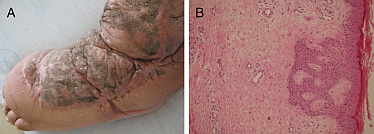ICEECE2012 Poster Presentations Clinical case reports - Pituitary/Adrenal (58 abstracts)
Elephantiasis nostras verrucosa as a presenting cause of Cushings’ disease
S. Zuhur , N. Demir , S. Velet , I. Kuzu , F Yener Öztürk & Y. Altuntas
Sisli Etfal Training and Research Hospital, Istanbul, Turkey.
Introduction: Elephantiasis nostras verrucosa (ENV) is a rare, chronic, deforming disorder characterized by hyperkeratosis and papillomatosis of the epidermis with underlying woody fibrosis of the dermis and subcutaneous tissue resulting from chronic nonfilarial lymphoedema. Lymphatic obstruction can be primary or due to various causes such as surgery, tumour, radiation, congestive heart failure or obesity. However, to the best of our knowledge, it has not been reported as a presenting sign of Cushing’s disease.
Case: A 28 years old male patient presented with obesity and left lower extremity enlargement and deformity which was present since 6 years. Physical findings revealed central obesity, purple stria on abdomen, buffalo hump and moon face. Non-pitting edema with lichenification, hyperkeratotic papules, nodules, and verrucous cobblestone-like plaques was found on left lower extremity. Histopathological examination of the tissue obtained by biopsy revealed dense dermal fibrosis, edema of the papillary dermis and extensive pseudo-epitheliomatous changes consistent with ENV. His laboratory findings demonstrated ACTH: 60 pg/ml (0–46 pg/ml), baseline cortisol level 26.8 μg/dl (6.2–19 μg/dl), midnight cortisol level: 17.17 μg/dl, urine cortisol level: 530 μg/24 h. Serum cortisol levels failed to supress after low dose dexamethasone supression test (DST) and supressed after high dose DST (1 mg: 9 μg/dl, 8 mg: 4.2 μg/dl respectively). A combined CRH-DST was consistent with Cushing’s disease (3.6 μg/dl). His pituitary MRI was normal. Inferior Petrosal sinus sampling was consistent with Cushing’s disease resulting from the left side of the pituitary gland. The patient refused trans-sphenoidal surgery.
Conclusion: ENV is a very rare disease. This case demonstrates that ENV may also developes secondary to Cushing’s disease. Therefore, patients with ENV should also be searched for Cushing’s disease.

Figure 1 (A) ENV on the left lower extremity of the patient. (B) H&E stained tissue section demonstrates dense dermal fibrosis, edema of the papillary dermis and extensive pseudo-epitheliomatous changes consistent with ENV.
Declaration of interest: The authors declare that there is no conflict of interest that could be perceived as prejudicing the impartiality of the research project.
Funding: This research did not receive any specific grant from any funding agency in the public, commercial or not-for-profit sector.




